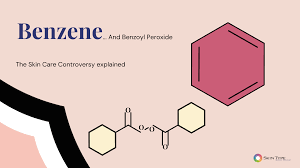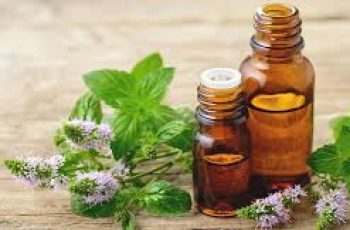
Benzene and Benzoyl Peroxide: What you need to know
Concerning headlines on Benzoyl Peroxide
The skincare industry is facing a pivotal moment with the recent revelation about benzoyl peroxide, an ingredient widely acclaimed for its acne-fighting properties. A study by Valisure (14) has highlighted a potential risk that under certain conditions, benzoyl peroxide may decompose, reacting with other ingredients in skincare products to form benzene. This discovery has sparked significant concern, given that benzene is a Group 1 carcinogen, placing it in the same category as asbestos, lead, and formaldehyde. The urgency of this issue has lead to a petition calling on major skincare brands, including ProActiv, Clinique, and Clearasil, to recall affected products. This situation demands a closer look at the implications of these findings and the chemistry involved.
If you plan on replacing your acne products, make sure you only get products that are right for your skin type. You can take the Baumann Skin type quiz for free here!
The Dangers of Benzene
Benzene’s classification as a Group 1 carcinogen by authoritative bodies highlights its potential to cause cancer in humans. Most often associated with industrial pollution, the presence of benzene in skincare products—especially at unsafe levels—is alarming. The U.S. Food and Drug Administration (FDA) has set a limit of 2 parts per million (ppm) for benzene in consumer products. However, the study in question found acne products with benzoyl peroxide containing up to 12 times this amount, raising serious safety concerns.
What is Benzene?
Benzene is a clear, colorless liquid with a sweet smell. It’s used in a variety of industrial processes and is a component of products ranging from plastics to detergents. However, its significance extends beyond its industrial use; benzene is frequently encountered in everyday life through environmental pollution. It can be released into the air from burning coal and oil, gasoline service stations, and motor vehicle exhaust. This widespread presence increases the importance of minimizing additional exposure, especially in products meant for our health.
Historical Precedent: the case of hydroquinone
The skincare industry has faced similar situations before, such as the withdrawal of hydroquinone from over-the-counter sales due to safety concerns. Hydroquinone was shown to metabolize into benzene, which obviously raised concern in consumers and skin care companies like. These precedents highlight the importance of rigorously assessing ingredient safety and the industry’s capacity to adapt by prioritizing consumer health.
Benzoyl Peroxide concerns
Interestingly, concerns of benzoyl peroxide causing skin cancer are not new and have been studied for decades. (11,12,13) This is why it is typically recommended to wash off benzoyl peroxide before going into direct sunlight.
I believe the reason this issue is only gaining public attention now is because of the proposed petition to recall affected products.
The potential for benzoyl peroxide to facilitate benzene formation in skincare products is significant for both consumers and the skin care industry. It emphasizes the need for careful product storage, handling, and the consideration of alternative acne treatments.
The formation of benzene in this context is reportedly due to the decomposition of benzoyl peroxide when it interacts with other ingredients within acne products. This decomposition process, potentially accelerated by factors like heat and light, is a reminder of the balance required in product formulation to for effective and safe results.
Alternatives for Benzoyl Peroxide
Given the concerns about benzene and benzoyl peroxide, exploring other acne treatment options becomes a priority. Effective alternatives include salicylic acid, which clears pores and reduces inflammation, and retinoids, which promote skin renewal without the risks of benzene formation. You can find our full collection of acne products without benzoyl peroxide here. Here are a few of my favorites:
Benzene Rings vs Free Benzene
As people become increasingly aware of benzene through moments like these, the distinction between terms like free benzene and benzene rings could be important to understand.
Benzene rings are benzene present as a structural component in many compounds. The term “benzene rings” in chemistry typically refers to benzene molecules that have bonded and become stable. Many such molecules are completely safe in skin care.
Free benzene has unbound binding sites, so it is highly reactive. This differentiation is crucial for understanding the specific risks associated with free benzene exposure versus the general presence of benzene rings in skincare ingredients.
While free benzene in isolation is carcinogenic, benzene rings are a common structural component of many safe molecules as well.
The Role of Benzene Rings in Molecules
Benzene rings are a fundamental aspect of organic chemistry, forming the backbone of countless compounds, many of which are pivotal to the formulation of safe and effective skincare products. These rings are characterized by a hexagonal arrangement of six carbon atoms, bonded in a way that creates a stable structure. This stability is a key feature, lending itself to the creation of diverse compounds with various properties beneficial to skincare. Compounds containing a benzene ring are often called “aromatic compounds.”
Making informed choices
Navigating skincare options in light of these findings can be challenging. Here are some steps to help:
Stay Updated : Keeping up with the latest skincare research ensures you make informed decisions.
Consult with Dermatologists : If you’re concerned about your skincare routine, talking to a skin expert can offer personalized advice and alternatives.
Explore Other Ingredients : Acne can still be effectively managed without benzoyl peroxide. Look into products with salicylic acid or retinoids.
Know Your Skin Type : Your skin’s needs are unique. The 16 Baumann Skin Types can guide you to products that match your skin perfectly. Consider taking the free skin type quiz.
Mindful Storage : If you continue using products with benzoyl peroxide, storing them in cool places might reduce the risk of any unwanted chemical reactions.
Moving forward
This recent revelation regarding benzoyl peroxide and benzene adds a new layer of complexity to skincare management. It serves as a reminder of the importance of staying informed about the products we use and the potential risks they may pose. By understanding what benzene is and its prevalence in the environment, consumers can make more conscious decisions about their skincare routines. Consulting with dermatology professionals, staying abreast of current research, and understanding one’s skin type are all prudent steps in navigating this issue. As the skincare industry continues to evolve, prioritizing safety and efficacy in product formulation will remain paramount.


